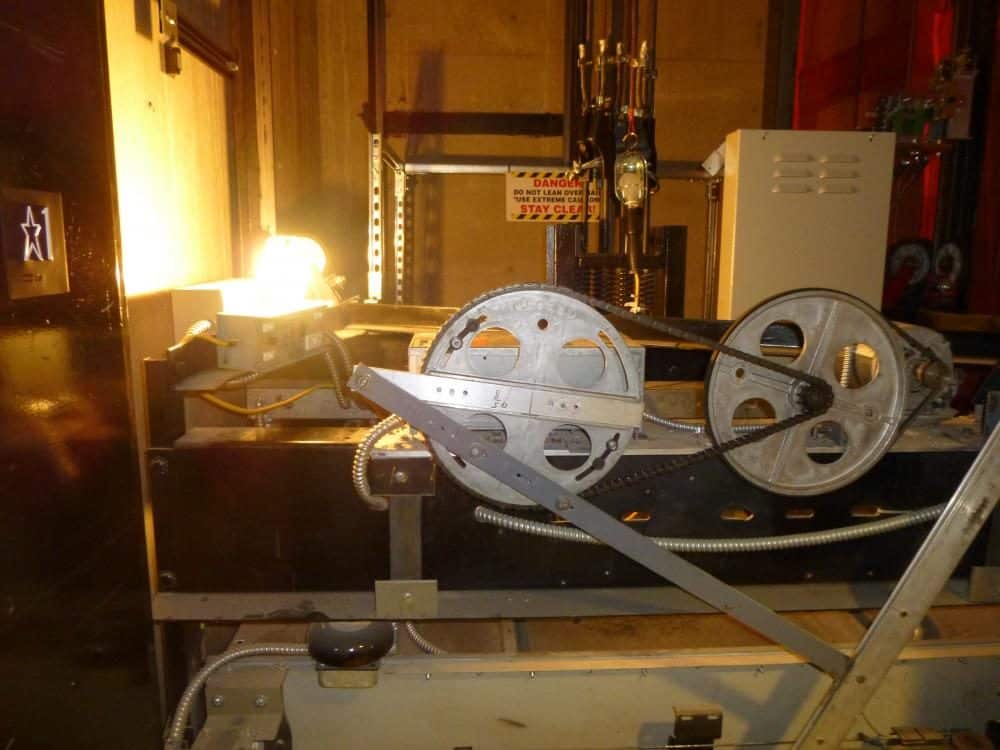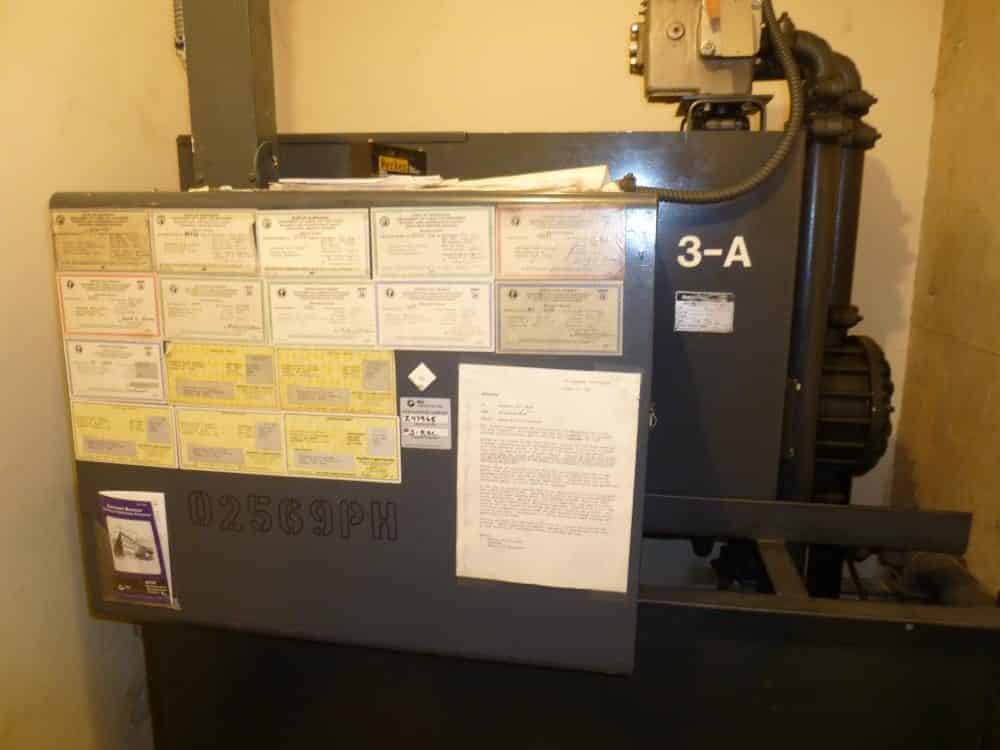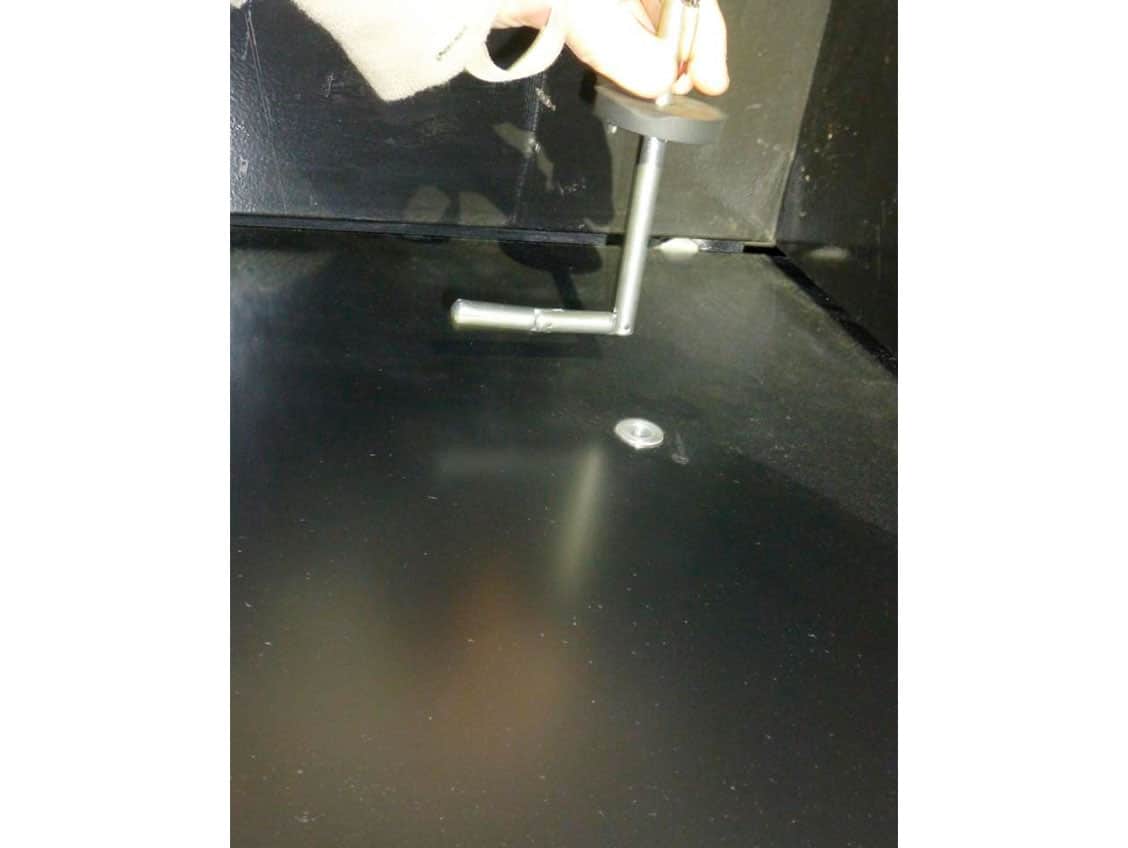
Consider this scenario: Your ladder company has been dispatched to assist an engine company that’s on a “person stuck in an elevator” call at a three-story assisted-living facility. The report indicates that there are several elderly residents stuck in the elevator; however, there’s a local power outage and the elevator technicians have an estimated 2–3 hour response time due to pending calls.
When accessing occupants trapped in a stalled elevator car, remember to send a member into the car prior to allowing the occupants to jump out. If needed, place the occupants in a harness and use a safety/belay line to secure them. Photo Andy Speier
Elevator Rescue Operations
Do you have elevators in your district? Do you have a plan for what to do when your companies arrive on scene? In this article, I’ll review some of the basics about elevators, initial action plan suggestions, tool assignments and some basic elevator rescue techniques for all levels of experience: awareness, operations and technician.
Advice Up Front: Call the Technician
I will say up front that 1) if there’s no life-threatening problem, 2) you haven’t had formal elevator rescue training and/or 3) you’ve tried initial troubleshooting but it hasn’t solved the problem, call for an elevator technician to respond to the scene. (I’ll discuss this more later.) Unlike firefighters, this is what they do full time so they know the equipment well.
If you’re attempting to remove someone from an elevator and it is a life-threatening emergency that involves some type of technical aspect, you should again ask for an elevator tech to respond immediately so that they can provide you with technical support. More than likely, you’ll get the trapped individual out of the elevator prior to their arrival, but it never hurts to call for help early. You can always send them home if they’re not needed.
Elevator Types & Locating the EMR
When responding to calls involving elevators, one of the first things responders will need to do is locate the elevator mechanical room (EMR). That is where the power shut-off is located. Depending on the type of elevator, the EMR may be located in a couple of different places, but the first place you could check when you arrive on scene is the building’s roof. Is it a flat roof with a large, box-shaped structure on top of it? If so, that’s most likely the EMR.
From the responder’s perspective, elevators can be broken down into two categories: electric motor and hydraulic. In a hydraulic elevator, a piston filled with fluid raises and lowers the car, which is usually smaller and slower than the electric-motor type of elevator, and they may be found in buildings as tall as six floors (e.g, parking garages, malls and community transit stations). Their EMRs may be located on any floor, and they may be as far as 100 feet from the elevator. Locating this room may be a challenge if it hasn’t been identified during an earlier visit to the building.
Newer, traction elevators (or electric motor) run on steel cables and counterbalance weights; older models may be a drum-type of elevator. EMRs for this type may be located on the roof or basement. Note: Regardless of the location of the EMR, the door will be locked.
Upon Arrival
As you pull up in front of the building, consider the location of the EMR as well as the following, which will determine your action plan:
- How many occupants are in the elevator?
- Is there a medical emergency?
- Is there a fire or other structural hazard present?
- Has an elevator technician been called?
- What is the estimated time of arrival for the technician?
- Do you have personnel trained to perform an elevator rescue?
- Will you need additional staffing and equipment?
Just like on a fire response, you should also bring a basic set of tools inside the building upon arrival.
Your next steps should include contacting the building manager, custodian or reporting party, if possible. In some cases, no one will be on site, the building will be locked and the call will have originated from the emergency phone located inside the elevator or from a cell phone call to 9-1-1. Gain entry using Knox box keys or your universal key (the irons).
Building Entry & Victim Contact
Once inside the building, leave a team member with a fireman’s service key in the elevator lobby. Locate the floor of the stalled car, which you may be able to accomplish in the lobby, as there may be a lighted display above the elevator that indicates the location of the car.
When you find the floor, make verbal contact with the occupants. The best way to communicate with the occupants will be to talk with your face up against the exterior hoistway door. In some cases, the occupants may be a bit distraught and need a bit of calm conversation. Explain to them that you’re going to get them out and that you’re going to ask them to do a few things to help you. If the audible alarm bell is still ringing, instruct the occupants to stop ringing the bell. This may mean that they stop pushing the button or they pull the button back out. If there’s more than one elevator in the building, summon the other elevator (if it’s working) and take a look at the panel. This will enable you to be able to give the occupant(s) specific instructions.
Initial Troubleshooting
Computers run many of the newer elevators. In troubleshooting elevators, we use some of the same logic that we use when working with a computer. The tasks on the troubleshooting checklist go through basic re-booting techniques. Tip: Just like with other re-booting techniques, wait 30 seconds before turning the power back on. In the case of re-booting elevators, this is done in the EMR with the elevator shut-off.
EMR Access
If there are multiple elevators in the building, note the elevator car number prior to heading off to the EMR; it will be posted above or next to the elevator door. As noted, once you reach the EMR door, it will be locked, so you’ll need a building master key or a set of irons. Tip: If access to the room is on the roof, the rooftop door should be chocked to prevent the door from closing and locking behind you. And as always, caution should be used when traveling on an unfamiliar roof in the dark.
Upon entering the EMR, locate the elevator shut-off switch, which will have a number that corresponds to the elevator car. Confirm the elevator car number. After initial troubleshooting techniques, the power will be turned off during all access attempts.
Elevator Key Use & Forcing the Door
There are specific elevator keys for specific mechanisms. Often, keys can be found in either the EMR or in an elevator key access box. Newer boxes will be locked and key access gained from a key stored in the building’s Knox box. The two most common keys are the articulating dropped key and the half-moon-shaped lunar key. The key hole will resemble the shape of the key. Drop keys will turn side to side while the lunar key will require a lifting motion. Both keys serve the same purpose: to open the hoistway door. I have found the drop key to be the most common type used.
Use of one of these keys releases a locking mechanism on the hoistway door. All modern doors will be a sliding type of door that’s held closed by an arm. Once the key is used to unlock the mechanism, you’ll need to exert sideways force on the door to get it to open. Important: If you don’t not know exactly where the car is in relationship to the landing, exercise extreme caution, as you don’t want to fall into an exposed shaft.
Hoistway doors can also be forced open using a set of irons, but that will cause major damage to the doors and may be dangerous to the rescuers. As such, this is a last-resort option that should be used during an emergency, such as when a person is stuck inside an elevator in a building that’s on fire.
Note: In the state of California, there are no elevator keyholes in the doors, so your options are to force the hoistway doors with a set of irons or use a Z key to release the latch. The Z key is a z-shaped piece of metal that can be slipped over the top corner of the door to trip the release on the inside of the hoistway door.
Accessing the Occupants
If you open the hoistway doors and find that the elevator car is 3 feet or more above the opening, use a portable ladder to create a barrier to prevent someone from falling into the shaft. The door will also want to close, so to keep it open, insert a chock at its base.
At this point, you should be looking at the inner elevator car door. There will be a latch to release the door or an arm that can be pulled to open the door. Once open, send a member into the car prior to allowing the occupants to jump out. If needed, place the occupants in a harness and use a safety/belay line to secure them.
The Poling Technique
If there’s no elevator key slot on the floor you wish to access, then you’ll need to move to an upper floor that has keyhole to access the shaft. In this scenario, team members working above the stalled car will need to be secured so that they don’t fall into the shaft.
Using a technique called “poling” with a pike pole or a broomstick, responders can (while lying on their belly) reach down from above and push open the mechanism holding the door closed on the floor below. While the release is in the open position, another member slides the door open. Tip: Use a glove-free hand if the door surface is slippery. If, due to the stalled car’s location, the inner door can’t be opened due to a safety interlock, then a car top removal technique may need to be deployed.
Car Top Removal Procedures
Depending on the number of personnel in your companies, this operation may require several companies, as you’ll need to have personnel equipped with radios at the following locations:
- Lobby at the firefighters’ service box
- EMR power shut-off switch
- Stalled car floor
- Above the car, “poling” the door
- The floor below, which will be the location of the stalled car or slightly below it, if between floors
With the power to the elevator turned off, open the hoistway door above the stalled car. Personnel entering the shaft should have PPE appropriate to secure themselves to the car top as needed (e.g., harness and safety tether). A ladder may also be needed to access the car top.
Prior to entering the shaft, visually locate the counterbalance weight for the stalled car and the adjacent car, and shut down the adjacent car to avoid any contact with it. Better yet, shut down the other car as well to avoid any contact with a moving car or counterbalance weight. Locate the car top shut-off and light switches. Turn off the car top power and turn on the car top light switch. Then locate the car top access panel. There may be a slide-bolt lock, wing nuts on threaded studs or other locking devices on the panel. Even with the locking mechanism open or removed, the access hatch is often stuck, so you may need a Halligan to pry it open.
Once you open the hatch, insert a ladder into the car top (a folding attic ladder works well for this) and send a responder into the car to talk with and organize the occupants. Remember: Each occupant who is removed should have some type of safety/belay line attached to them—a victim harness attached to a rope that’s staffed on the landing provides a simple means of accomplishing this. A responder should be stationed on top of the car to assist occupants over the top of the car and past the elevator door opener.
Moving Hydraulic Elevator Cars
Lowering a hydraulic elevator so that it lines up with the landing is becoming an accepted access technique. To perform, use the bleeder valve in the EMR at the reservoir tank to lower the car. Note: As with all elevator rescue operations, follow all initial troubleshooting techniques and then follow the steps on the checklist. Slowly open the valve partially and communicate with a radio-equipped member who should be watching the car (the hoistway door will be open). Stop the car several inches above the landing, as there is a reaction time on the part of the member at the valve and the fluid movement. Electric cable/traction elevators can be lowered as well, but that operation is best left to the elevator technician.
A Note about Occupancy Type
The type of occupancy may be a factor when considering why you’re responding to a stuck elevator. Elevators located in places of public assembly where there are sporting events (with loud, young fans) may experience more elevator issues. Overcrowding and/or jumping around may set off the elevators over-speed switch or emergency brake. If this has happens, the elevator will not move until the technician resets it. At this point, operations or technician-level skills will need to be used to access the occupants; however, if there’s no medical emergency or fire, your awareness-level troubleshooting techniques don’t work and your personnel haven’t been trained, wait for the elevator technician. A structured elevator response training program and response SOGS will improve the outcome on these types of incidents.
What Happened?
So what happened at the assisted living center during the power outage? Upon discovering that the car was between floors, ladder company personnel lowered the hydraulic elevator to the next landing where they could remove the occupants from the car. The power was left in the off position, and the elevator company was contacted and informed that there was no longer anyone in the elevator.
Sidebar 1: Elevator Rescue Skill Level Breakdown
Awareness Level
Awareness-level tactics involve basic trouble shooting techniques:
- Identify location and condition of elevator car.
- Determine number of occupants and triage their condition.
- If occupants are ringing bell, instruct them to stop.
- Ask occupant to cycle the power. Ask them to use the STOP button, wait for 30 seconds, and then turn it back on. Ask them to push the Door Open button.
- Call the elevator using the elevator call button.
- Use firefighter’s service recall from the lobby.
- Access EMR and elevator control panel.
- Verify location of correct power shut-off switch with elevator car number or geographic relationship to other elevator banks.
- Shut off elevator power, wait 30 seconds, then restore power.
- Call the elevator.
- Use firefighter’s service recall.
- Call elevator service technician.
Operations Level
Operations-level tactics use more advanced access tools. When performing a hoistway door access removal, tactic include
- Get an ETA from the elevator repair technician.
- Communicate the plan to the car occupants.
- Shut off elevator power utilizing lock-out/tag-out procedures for specific car.
- Using elevator key or tool, open hoistway door to determine location of elevator.
- For floors without key access, use the “poling” technique from the floor above.
- If car is level with landing, open car doors to access occupants.
- If car is more than 3 feet above landing, block off the bottom with a ladder.
- Hydraulic elevator: Bleed fluid to lower car (maintain open radio contact on a Tac channel during this and all operations involving potential movement of the elevator car).
- If car is more than 3 feet above the landing, send fire/rescue member into car prior to allowing occupants to leave the car to assist.
- Use appropriate safety/belay technique with occupants prior to removing them from the car.
Technician Level
Technician-level tactics involve members working in the shaft. When performing a car top access/removal op, tactics should include
- Communicate the plan to the car occupants.
- Confirm power shut-off.
- Open hoistway door above stuck car using key or poling technique as needed.
- Don appropriate PPE.
- Shut down and lock-out adjacent elevator if applicable. This must be done in congruence with lock-out/tag-out procedures in the case of a shared, open shaft.
- Access car top emergency access panel using attic ladder as needed.
- Shut off power switch on top of car.
- Turn on auxiliary light.
- Locate and open car top emergency access panel.
- Place an attic ladder into car.
- Send rescuer into car.
- Place car occupant into harness, with safety rope belayed from elevator lobby.
- Assist occupant through emergency access panel, into shaft and up to lobby.
- Secure elevator access and return everything to original condition.
- Leave power off in EMR until it’s restored by elevator technician and post “out of order” signs in the elevator lobbies.
Sidebar 2: Elevator Incident Response Equipment
- Elevator keys
- 8′ pike pole
- Attic ladder
- Two Class II or III harnesses
- Rescue rope and carabiners
- Victim harness
- Lock-out kit
- Hand lanterns
- Door chocks
- Set of irons
- Basic tool kit (screwdriver and wrenches)








